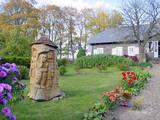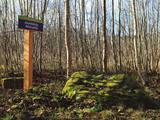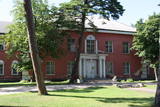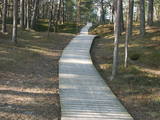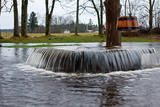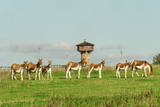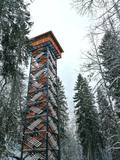| Nr | Name | Beschreibung |
|---|---|---|
|
Die Wirtschaft beschäftigt sich mit der Züchtung von reinrassigen und gekreuzten Rindern für Zucht, Mast und Fleischherstellung, mit dem Verkauf von Milchschweinen und mit der Herstellung des Schweinefleisches und Züchtung von Getreidepflanzen und Kartoffeln, sowie mit der Imkerei. Schon mehrere Jahre züchten die Wirte in sechs Teichen der Wirtschaft Karpfen, Schleien und Orfe. In der Wintersaison kann man Fische in besonderen Becken des Fischhauses fangen, die eingerichtet sind, indem ein Bogen des Flusses Bērzene überschwemmt wurde. Die Wirtschaft bietet Einsicht und Vorlesungen in der biologischen Wirtschaft und Züchtung von Rindern für Fleischherstellung, darunter auch in der genetischen Arbeit mit der Erhaltung einer reinen Rasse, sowie Angeln in frischer Luft. Für Seminare und Vorlesungen sind im Fischhaus ein Seminarraum und eine Küche gebaut worden. In der Wirtschaft befindet sich und wird ein Pfad erhalten, der Oskars Kalpaks gewidmet ist und der ein geologisch und landschaftlich interessantes Gelände durchquert. |
||
|
Das Museum wurde 1968 eröffnet. Der Obstgarten ist ein untrennbarer Bestandteil des Hofes, der von den Museumsmitarbeitern gehegt und gepflegt wird. |
||
|
Der originelle Handwerker ist ein Vertreter einer Töpferschule (Pūdnīku skūla), die die Traditionen ihrer Vorfahren fortsetzen. In seiner Werkstatt "Malny Wylky" (schwarze Wölfe) kann man diesen überlieferten Prozess sehen, angefangen bei einer fußbetriebenen Töpferscheibe bis hin zu einer speziellen Brenntechnik in einem Holzofen in einer Brenngrube. Man kann bei der Arbeit zusehen oder fertige Waren kaufen. Vēsma malt Ölgemeinde und zeigt ihre Arbeiten. |
||
|
Atrodas 0,9 km no Jaunpiebalgas muižas pils, Jaunpiebalgas centra virzienā. Redzot šo ēku, nav jāpārliecina, ka tā ir viena no garākajām Vidzemē. Tik gara, ka grūti pat „iedabūt kadrā”. |
||
|
The tour introduces modern day life in rural Finland, Estonia and Latvia and includes visits to small farms raising livestock and producing delicious foods, and to ethnographic villages preserving the traditional lifestyle in a contemporary environment. The tour also involves sites of historical and cultural interest. |
||
|
Das Café befindet sich im historischen Zentrum von Tukums. Hier werden köstliche lettische Leckereien angeboten: Brötchen, Blechkuchen und Piroggen. |
||
|
Die Kollektion von Pfingstrosen in diesem Garten umfasst jetzt fast 400 Sorten und die Sammlerin Dagnija Voika ist stolz darauf, eine der größten Sammlungen in Lettland zu haben. Von den als Strauch wachsenden Pfingstrosenarten sind 30 Sorten vorhanden. Zudem wachsen hier auch diverse Schwertlilien, großblütige und sibirische, sowie eine Sammlung von Taglilien. Hinzu kommen einige weniger bekannte Zierpflanzen wie Yucca und Steppenkerzen. Gäste sind insbesondere in der Blütezeit der Pfingstrosen im Juni willkommen, dann gibt es auch ein Pfingstrosenfest und es werden Führungen angeboten. Aus den wertvollen Wurzeln der Pfingstrose wurde die Kosmetikserie PEO kreiert. Man kann auch Jungpflanzen kaufen. |
||
|
Jaunstašuļi Devil's Footstone is situated in the village of Jaunstašuļi in overgrown place beside the
derelict houses. It is hard to find it without the guide. The boulder is 0,75 m high and its circuit is 5,85 m.
On the surface there is the human foot: the length 0,3 m, width 0,09 m, depth 0,02. There was another foot.
It’s obviously scaled off. The North side of the boulder has three casted steps.
|
||
|
Zemnieku saimniecībā "Rudzīši" iespējams apskatīt dažādus mājputnus - vistas, tītarus, dažādu šķirņu pīles un zosis. Mini zoo mīt arī cūkas, aitas un kazas. Tiek piedāvāta izjāde ar poniju, kā arī iespēja pārnakšņot brīvdienu mājā. |
||
|
Diese Schänke befindet sich in dem historischen Zentrum von Ligatne (am Teich): In einem Gebäude, wo das erste Papier von Ligatne hergestellt wurde. Lettische Küche: Stroganoff der Region Vidzeme, gegrillte Strömlinge aus dem Dorf Kolka, gegrilltes Schweinefleisch, Forelle des Flusses Amata, Kartoffelpfannkuchen mit ländlichen Sauerrahm, hausgemachte Pfannkuchen mit Marmelade, Bier und Kwass. Das besondere Gericht: Dessert "Lustūzis". |
||
|
Ein Stadtbaudenkmal der 17 – 19 Jahrhunderte von staatlicher Bedeutung. In den Umgebungen der Straßen Jelgavas und Rātūža ist eine ehemalige Straßenplanung erhalten, die eine geschlossene Bebauung des Stadtviertels bildet. In Jaunjelgava befinden sich lutherische, katholische, orthodoxe und baptistische Kirchen. Eins der hervorragenden Architekturdenkmäler ist das 1912 in den Jugendstilformen gebaute Rathaus. Bis heutzutage ist keine der fünf Synagogen erhalten. Entlang des historischen Zentrums von Jaunjelgava ist am Daugava-Ufer eine Uferpromenade errichtet – ein beliebter Platz der Stadtbewohner für Spaziergänge, Erholung und Baden. |
||
|
Das ehemalige Kriegshospitalgebäude ist von einem Park umgeben, nördlich ist ein Küstenpark gelegen. Das Gebäude hat verschiedene kleine architektonische Formen.
|
||
|
This is the oldest arboretum in Latvia. It was planned by the owner of the Skrīveri Estate, Maximmilian von Sievers (1857-1919). It has to be said that before World War I, there were two times more species of plants in the park than is the case now. The plants are grouped in accordance with the geo-botanic regions of the world. There are trails in the park, and signs showing the Latvian and Latin name of each plant are there, as well. There’s a fountain which is operated from every hour on the hour from 11:00 AM until 11:00 PM from Tuesday until Sunday. On the other side of the Rīga-Daugavpils highway is the Skrīveri Forest Park with hiking trails.
|
||
|
Dieses Territorium schützt die Biotope der Küstendünen und der Dünen von Plieņciems, die sich über die ganze Strecke bis nach Ķesterciems erstrecken. Das ist ein vielbesuchtes Gebiet, aber das Objekt Plieņciems wurde nicht ausgebaut. Es gibt jedoch einen hölzernen Fußweg durch die Düne zwischen Plieņciems und Ķesterciems. Hier wurde auch ein Erholungsgebiet errichtet.
|
||
|
Auf dem Hof wird Hanf angebaut und es wird angeboten, sich mit der Geschichte und den vielfältigen Verwendungsmöglichkeiten bei der Ernährung und in der Sauna bekannt zu machen. Zu den Erzeugnissen des Hofs gehören Hanfbutter und Hanfmilch. Es gibt Führungen und man kann die Produkte des Hofs kaufen. |
||
|
The cafe Baravika is situated in the centre of Rezekne city. It offers a wide variety of dishes. Working hours: Mon-Fri 8.30 līdz 18.00 |
||
|
Der Ort Tuhala ist schon seit 3000 besiedelt. Im Gebiet befinden sich 11 prähistorische Siedlungsreste, 30 Opfersteine, 3 Hügelgräbe, 4 Heiden u.a. Im Landschaftsschutzgebiet Tuhala befindet sich der unikale Hexenbrunnen, aus dem beim Hochwasser bis 100 l Wasser herauskocht, und fünf Estlands mächtigste Energiesäulen. |
||
|
Te plašos aplokos mīt 38 sugu savvaļas dzīvnieki (kiangi, lāči, lūši, vilki, meža cūkas, aļņi, vāveres, plēsīgie putni) un visdažādāko šķirņu mājdzīvnieki – Latvijas zilās, Hailandes un Galovejas govis, Romanovas aitas, Vjetnamas cūkas, pīles, zosis, tītari u.c. Acīgākie dīķos pamanīs retās Eiropas kokvardes. Kalvenes pagasta „Cīruļi” – tā ir lieliska, nesteidzīga atpūta lauku vidē, iepazīstot dzīvo dabu! Darba laiks no novembra līdz martam: katru dienu no 10:00 – 16:00 |
||
|
Dies ist die längste Waldweg-Tour, bei der Sie auf vielen schönen Wald-Naturpfaden in Lettland und Estland wandern. Diese Naturpfade sind Teil des Waldweges und diese Tour eignet sich für selbstfahrende Touristen, die Wanderwege unterschiedlicher Größe wandern und sich einen Eindruck von der Waldvielfalt in beiden Ländern verschaffen möchten. Sie haben die Möglichkeit, die nördlichen Nadelwälder mit Fichten und Kiefern, Laubwäldern, feuchten Auenwäldern und malerischen Wäldern zu sehen, die an Hängen und Schluchten wachsen. Sie werden auch die interessantesten Sehenswürdigkeiten in Lettland und Estland sehen, die sich in der Nähe des Waldweges befinden. In Lettland besuchen Sie Sigulda, das historische Papiermühlendorf Ligatne, das mittelalterliche Cesis und das Amata-Tal, das sich im Gauja-Nationalpark befindet. Anschließend fahren Sie in den weniger bevölkerten östlichen Teil Lettlands - das geschützte Landschaftsgebiet Nord-Gauja, die Stadt Aluksne, und wandern in der subglazialen Depression Korneti-Peļļi, einer der beeindruckendsten Schluchten Lettlands. Sie können den Drusku-Burghügel besteigen - den höchsten und steilsten aller Burghügel in Lettland. Wenn Sie nach Estland kommen, sehen Sie den höchsten Punkt des Baltikums - den Suur Munamagi-H Weiter führt Sie die Tour in das Tal des Flusses Piusa, Obiniza, mit der Kultur des Seto-Volkes. Anschließend wandern Sie zu dem historischen Ferienort Varska, nahe gelegen an der Grenze zu Russland. Dann erreichen Sie Artu und den Peipsi-See, den füntgrößten See in Europa. Sie werden zum Landschafts-Schutzgebiet Kurtna reisen, den Kalksteinfelsen Ontika sehen und den Wasserfall Valaste - den höchsten in Estland. Schließlich erreichen Sie eines der schönsten bewaldeten Gebiete in Estland - den Lahemaa Nationalpark. Ihre Tour endet in Talinn. Dort lohnt sich der Besuch der Altstadt und die Entdeckung weiterer Attraktionen. |
||
|
Dabas liegumā "Lielie Kangari" atrodas 33 metrus augsts skatu tornis, kura virsotnē atrodas platforma, no kuras paveras skats uz Kangaru ezeru un Lielkangaru purvu. Dabas liegumā izbūvēta arī nepilnu divu kilometru gara pastaigu taka ar tiltiņiem un skatu platformu pie ezera. Takas sākumā izvietotais veselības maršruts ikvienu apmeklētāju aicina kārtīgi izvingroties un izkustēties. Apmeklētāju informēšanai un izglītošanai visas takas garumā izvietoti arī informatīvie stendi ar fotogrāfijām, kas apvieno varenu stāstu un teiku kopumu par notikumiem, vietām, tēliem un parādībām dažādās apkārtnes vietās. |
||


